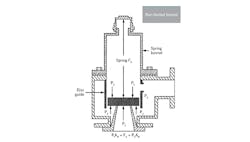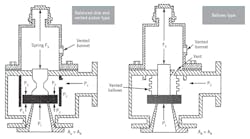Ask the experts: Relief valves and back pressure
Q: With reference to your ongoing series of articles in Control on pressure relief valves, I'd like to understand the considerations that would help to decide when to use balanced bellows-type safety valves and when to use those provided with balancing piston pilots? Are there any specific guidelines that will help engineers to decide when to use which?
Pinal Bhatia
[email protected]
A1: The answer to this question is explained in full detail in Volume 1 of the 5th edition of my Instrument and Automation Engineer’s Handbook. Here I will give a brief summary.
As shown in Figure 1, a conventional pressure relief valve (PRV) starts to open when the force generated by the process pressure (P1) reaches the spring force (Fs) that keeps the valve closed. But, because the spring is moving while the valve is opening and therefire Fs is rising a little, the pressure will rise some 3% above the pressure at which it stared to open before full opening is reached. The lifting force is the product of the process pressure (P1) and the nozzle area (AN).
When the PRV starts to discharge into the atmosphere or a receiving header, the forces acting on the disc change. The lifting force can drop because it's lowered by the pressure drop through the inlet nozzle, and on top of that, the closing force can increase because the back pressure (P2) acting on AN will produce a force (P1AN) that will be added to the spring force. This back pressure (PB) is added to the set pressure (Ps) of the valve. The combined effects of these forces can cause the valve to reclose and then reopen or chatter. The backpressure can be constant or variable. It will be variable if the pressure in the collecting header rises and falls as the flow from the PRV changes (or the flow from any other relief device served by the header changes).
Figure 2: If the piston (AP) and bellows areas (AB) accurately match the nozzle area, both of these designs eliminate the back-pressure effect on the PRV setpoint.
Blowdown (BD) is the difference between the set pressure (Ps) and the reseating (closing) pressure, and is usually expressed in % Ps units. It has to exceed 2% to prevent chatter, and it can range from 2% to 7%, but it's usually around 6% of Ps.
One way to eliminate the back-pressure effect on the set pressure is to use balanced PRVs. The balanced design can be the piston type (left in Figure 2) or the bellows type (right in Figure 2). Both will work as long as the nozzle area (AN) is the same as that of the piston area (AP) on the left or that of the bellows area (AB) on the right. If the areas aren't perfectly matched, a little back-pressure effect will remain. Besides providing a balanced design, an added advantage of the bellows design is corrosion protection, if that's needed.
As to which design to use in your application, I'd use both. I'd add bellows to the piston and use them in combination. This is because one should use bellows in any case when the total back pressure is greater than about 10% of the set pressure and because having an auxiliary balanced piston acts as backup for the bellows.
Béla Lipták
[email protected]
A2: I'm not certain if your question is about the use of bellows safety valves in general or specifically about bellows safety valves with an auxiliary piston. Hopefully my answer gives you the information you need.
Normally, one chooses a bellows safety valve over a conventional safety valve when the total back pressure is greater than about 10% of the set pressure. (The total back pressure is the sum of the normal back pressure that's always present on the discharge plus the superimposed back pressure that occurs when the relief valve is lifting. Note that this superimposed back pressure might be caused by the flow of the relief valve or by the flow of other relief valves discharging into the same header.)
If a conventional relief valve is used in a back pressure service, it will not perform for two reasons. First, the normal back pressure will add to the relief-valve setpoint—a 10 psi constant back pressure will make the relief valve lift at a pressure 10 psi over its normal setpoint. The second problem is that superimposed back pressure will act to force the relief valve closed, usually resulting in a chattering situation where the valve opens, flow starts, back pressure builds, the valve slams closed, then promptly reopens again.
A bellows relief valve is used in this service because the bellows keeps the back pressure from acting on the back of the disk. Therefore, the setpoint remains unchanged despite the back pressure and the superimposed back pressure will not force the valve closed. (Do note that if the superimposed back pressure is higher than about 50% of setpoint, the total flow through the valve will be reduced, so the valve should be sized accordingly.)
The only difference between a regular bellows valve and a bellows valve with an auxiliary balanced piston is that the piston acts as a backup for the bellows. Should the bellows fail, the piston will act similarly to the original bellows, and allow the valve to continue to operate in back pressure conditions. It may leak a bit, but it will work. If the valve doesn't have a balanced piston, a bellows failure might make it act more like a conventional relief valve.
P. Hunter Vegas
[email protected]
A3: To specify a safety valve correctly, the most important factors are the set pressure at which it will operate, the process conditions of the fluids, and the back pressure on the valve.
If the valve relieves to atmosphere and the set pressure is relatively large versus the normal operating level, then a standard safety valve can be specified.
If the valve relieves to a system with fixed back pressure or back pressure which should not vary, then you would be using a bellows-type safety valve.
If the valve relieves into a system with variable back pressure and you want to seal the bellows from the process fluids, use a balanced bellows with auxiliary balance piston.
The Crosby Pressure Relief Valve Engineering Handbook is freely available in PDF form at swan-associates.com/documents/Eng_Handbook.pdf and contains more details.
Alejandro Varga
[email protected]


